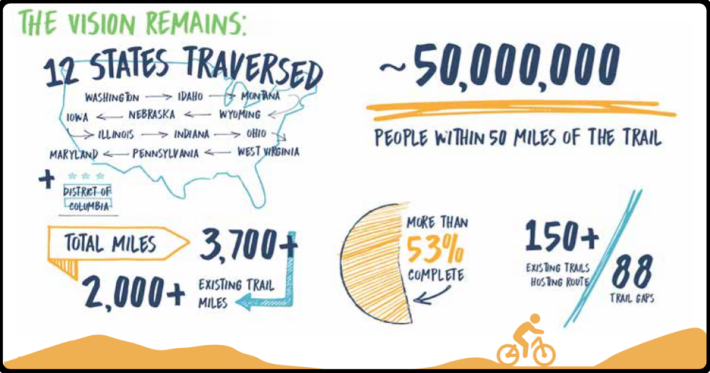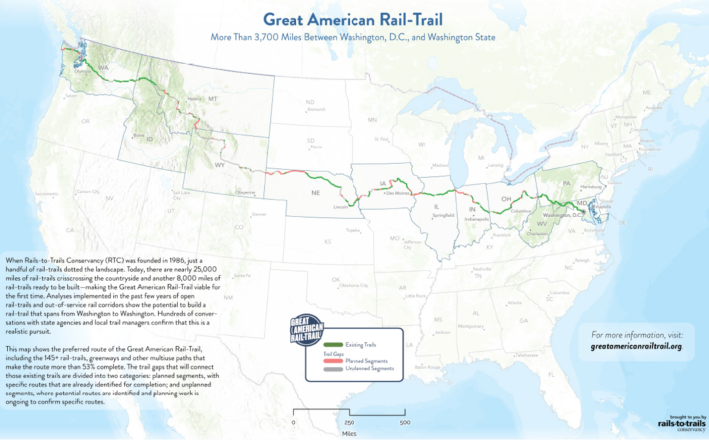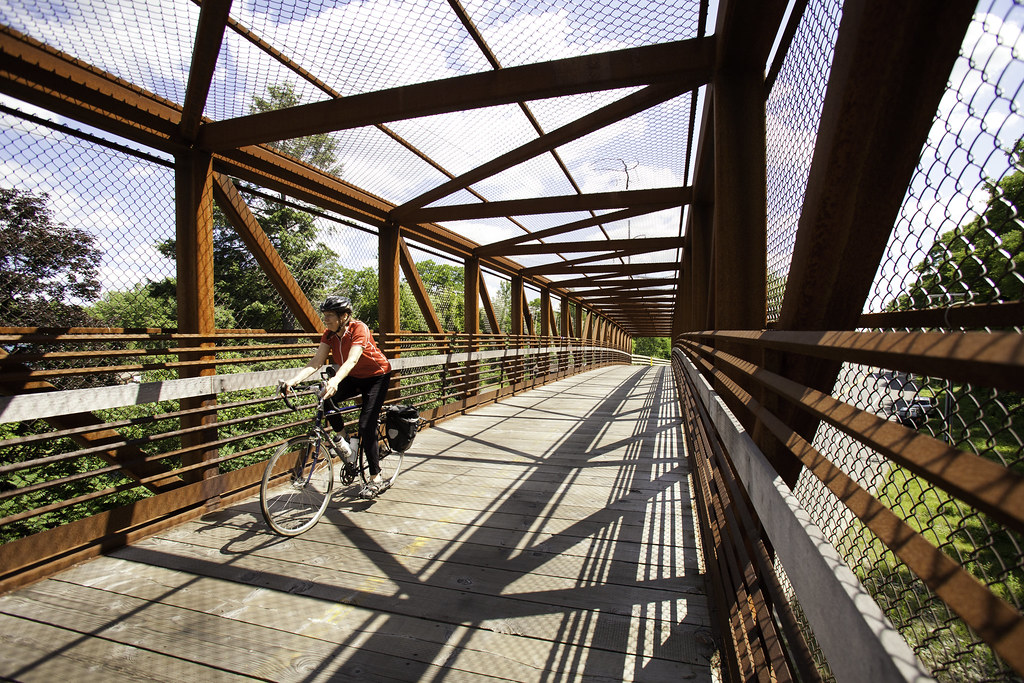A continuous cross-continental active transportation trail would pay for itself in less than five years in visitor spending alone, a new analysis argues — and it could have a big impact on the car-free transportation landscape in the communities it runs through, too.
According to a new report from the Rails-to-Trails Conservancy, completion of the Great American Rail-Trail — a 3,700-mile shared-use path stretching from the Capitol steps in Washington, D.C. to the coast of Washington State — would generate more than $350 million per year in economic activity in the form of tax revenue, income for workers, and tourism dollars for local communities.
That's less than a third of the $1-billion the group estimates it'd take to fill the gaps in the existing trail, which is 53 percent complete today. Each of the 12 states along the route have already repurposed some former rail lines into off-road spaces for biking, walking, and other non-automotive modes, though some still need to separate vehicle traffic from active travelers along portions of their routes, including many of the segments that pass through urban areas.
When that happens, though, experts say the economic impact will be huge — and so will the mobility impacts for residents of the towns the route ones through.
"This vision is really about both transportation and recreation," said Liz Thorstensen, vice president for trail development at Rails-to-Trails. "Even right now, this route is made up of over 120 local trails that are all part of local active transportation systems, but they're not all very well connected. By filling in the gaps, not only are you completing the Great American Rail-Trail, you're also helping to complete these important [intracity] networks that make it easier for these regions to get to work, to school, to the grocery store, without getting in a car."

Despite the Great American Rail-Trail's economic and transportation potential, Rails-to-Trails says lawmakers have been slow to make it a priority. As part of the recent Bipartisan Infrastructure Law, Congress approved $500 million per year for an Active Transportation Infrastructure Investment Program specifically to fund projects like rail trails, but left it up to the discretion of lawmakers to actually fund it each year.
"Lots of communities are already securing funding for their segments of the trail, including federal funding, but it's happening in a piecemeal way," added Thorstensen. "The Active Transportation program is a great opportunity to get this project a dedicated funding source, and to accelerate this work."
If the trail gets the federal support it needs, Thorstensen says it will have big implications for rural and urban communities alike. The route already touches populous areas like Seattle, Wash. and Columbus, Ohio, and it promises to bring protected biking and walking space to huge swaths of America that currently have little of it.

Thorsten says there's particular potential in Wyoming, where stakeholders see the trail as an exciting opportunity for economic development — and a chance to introduce a little-used mode to more residents. (The Cowboy State currently ranks dead last on the League of American Bicyclists' Bicycle Friendly States ranking.)
"We're not trying to just look through our trail development lens and plop down a trail without community input," she adds. "We want this project to support all different kinds of goals in rural and urban contexts. In urban areas, that's mostly about accelerating those local trail projects that are already in the [active transportation] master plan. But as you get into the exurbs and rural areas, that's where a lot more brand new opportunities will be generated."
If the Great American Rail-Trail can reach its funding goal, Thorstensen says it may be a couple of decades before the ambitious project is fully complete. In the short term, though, she says it's already inspiring a conversation about how communities can work together to build comprehensive networks of rail-trails, rather than just standalone routes — so that someday, there might be a network of connected active transportation interstates every bit as extensive as the interstate highway system.
"It's pretty novel for the United States to think about [allowing residents to] live in a trail network that you use in daily life, in the way that people already do in Europe and, increasingly, in South America," Thorstensen adds. "We could someday live in a nation that's fully connected by rail trails and multi use paths. That's the big vision."






